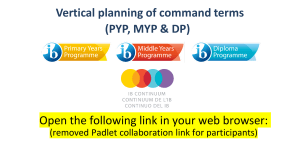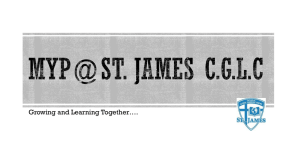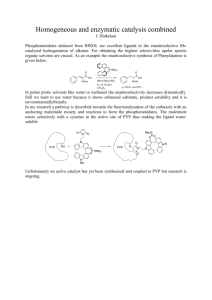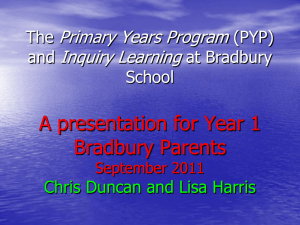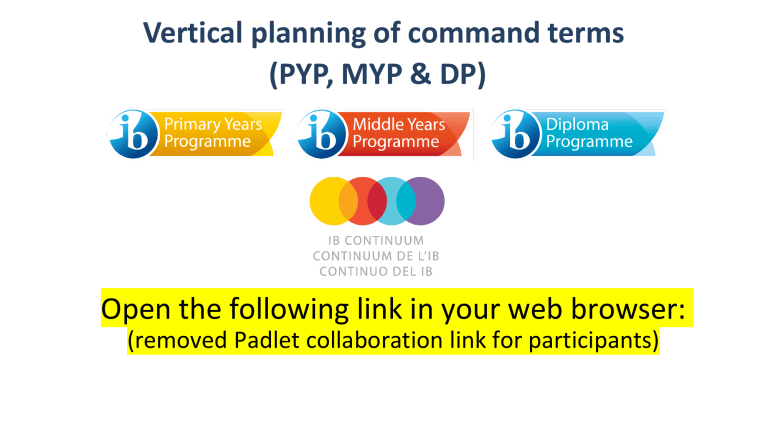
Vertical planning of command terms (PYP, MYP & DP) Open the following link in your web browser: (removed Padlet collaboration link for participants) Vertical planning Vertical Planning is to allow for us as teachers to meet within subject groups/disciplines to discuss and plan approaches to teaching, learning and implementing command terms with the input from the PYP, MYP and DP teams, to support backward planning and academic rigour. Purpose? Standard C1: Collaborative planning 3. Collaborative planning and reflection addresses vertical and horizontal articulation. Standard C3: Teaching and learning 3. Teaching and learning builds on what students know and can do. 8. Teaching and learning demonstrates that all teachers are responsible for language development of students. The associated verbs (command terms) used in SOLO Taxonomy (PYP) See page 4 of the guide ‘SOLO Taxonomy’ from the IB Programme Resource Centre (PYP) or on Padlet. MYP/DP see your subject guides. Designing learning outcomes across a unit of inquiry Uni-structural (I have one idea) Multi-structural (I have many ideas) Relational (I can connect my ideas) Extended abstract (I can take my ideas further) Example: List properties of different solids, liquids and gases. Example: Compare the properties of different solids, liquids and gases. Example: Design an experiment to test properties of matter. Describe, outline, list, follow a procedure to… Sequence, classify, compare and contrast, explain causes or effects, analyse, make an analogy, organize, distinguish, interview, question, apply dissect, test, establish. Generalize, predict, reflect, evaluate, hypothesize, create, prove, plan, justify, suggest, argue, compose, prioritize, design, construct, perform, invent, conclude, criticize, debate, explain, give reasons, grade, judge, recommend, support, test, validate. The verbs used in SOLO Taxonomy (PYP) Sample central idea: Example: Understanding Name a property of a properties of matter solid, liquid and gas. enables people to manipulate materials to meet their needs. Command terms PYP, MYP, DP (These can be used by teachers and students to help construct learning outcomes). Define, identify, name, draw, find, label, match, recall. Source: PYP SOLO Taxonomy guide. October 2018 (Updated December 2018). Where do we go from here? • Continue to document, plan and implement SOLO taxonomy and the command terms (unit planners PYP, MYP & DP) throughout the year and look closely how this can happen through approaches to teaching. • Work more closely with other teachers across the school focusing on shared understanding of IB terminology, to support academic rigour and the IB continuum at our school. 1. In your groups, discuss how the command terms are currently used in activities, lessons, assessments and also our understanding of the command terms. 2. MYP and DP can share how the command terms are currently implemented with the PYP and vice versa. 3. How can we design tasks and use the command terms? 4. In your groups, come up with an essential agreement/common understanding for implementing the command terms for Preschool/PYP, MYP and DP. Share/type your shared agreement on the Padlet link.
